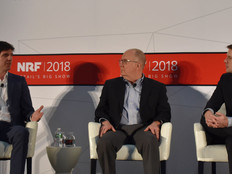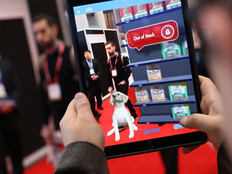NRF: How Retailers Can Grab Value in the Shift to Digital
Retailers are changing how they invest in new technologies as they undertake digital transformation journeys.
“Digital transformation is our path forward in retail,” said Kathryn Howe, senior adviser to retail industry clients for Cisco Systems during a panel discussion at NRF 2018: Retail’s Big Show in New York City on Jan. 15.
“Things have changed in the digital era,” Howe continued. In the past, retailers focused their investments on customers, but they are shifting to investing in their employees, Howe said. “If we give employees the tools to do their job better, that will benefit the customer,” she said.
Cisco has predicted that by 2026, $2.8 trillion in value will be at stake as retailers embrace digital technology, Howe noted. Retailers can capture that value in six different ways, according to Howe:
-
Employ productivity tools, which includes in-store analytics, checkout optimization and digitized interactions
-
Improve innovation and insights, including via assortment optimization, out-of-stock reduction and connected marketing
-
Enhance the customer experience via self-serve channels and checkout optimization
-
Improve asset use (including cybersecurity and loss prevention)
-
Optimize the supply chain and logistics (including connected supply chain and click-and-collect solutions)
-
Embrace sustainability (including smart grid technologies)
SIGN UP: Get more news from the BizTech newsletter in your inbox every two weeks!
The Road to Retail Digital Transformation
How can retailers practically undertake digital transformation? Howe discussed Cisco’s retail digital transformation roadmap framework and noted that there are three key steps.
First, retailers should “enable,” creating IT agility and operational efficiency. Second, they should try to differentiate their brands, and provide unique digital capabilities and services. The last step is to define new business models to create true disruption.
Before retailers can achieve any one of these three pillars, Howe stressed that they need to lay the technology foundation to support those initiatives. To help with the first pillar, retailers must focus on their data center, collaboration technology, the cloud, security and application monitoring.
Likewise, before retailers can differentiate their brands, they should look to install technologies such as beacons, Internet of Things sensors and radio frequency identification (RFID) tags. Finally, to truly be disruptive, retailers should look into emerging technologies such as augmented reality, virtual reality and artificial intelligence, Howe said.
Panera Bread Deploys a Host of Tech Tools
Some retailers are already on their digital transformation journeys. Panera Bread has been in business for 31 years and has 2,100 stores nationwide. As the company grew, it realized the importance of digital transformation. “For us, it was about the customer experience,” Michael Wojcik, vice president of enterprise technology for Panera, said during the panel discussion. Panera wanted to increase sales through a rapid pickup solution, he added.
The restaurant chain completed their digital transformation project in three phases.
First, Panera rolled out a wireless network through Cisco’s digital-ready network to provide customers with a great experience.
Second, the company rolled out a mobile ordering system that allowed customers to order food through Panera’s website up to five days in advance and then come into the store to pick it up. This significantly reduces the amount of time customers must wait for their food, since it will be waiting for them when they arrive. Panera also deployed kiosks in its restaurants that allow dine-in guests to order food and have it brought to their table. Panera’s loyalty program remembers a guest’s orders for quick ordering in the future.
“If they are using the kiosks, they are engaging with a us more,” Wojcik said. “We are seeing an uptick in transactions.”
That has helped Panera grow its loyalty program. The company first deployed advanced ordering and rapid pickup before rolling out self-serve kiosks.
“We had to introduce the technology to the customers through ambassadors,” Wojcik noted. “Once the customers learned how to use the technology, we saw an increase in use frequency.”
Panera looked at how other industries were approaching technology and then applied lessons learned to its retail restaurant businesses, he continued. The rise of smartphones, has led to customers having higher expectations that their experience will be personalized and engaging.
The restaurant chain has also implemented IoT solutions to monitor customer behavior so that the employees wouldn’t have to do that. “A happy employee is going to be a happy customer,” said Wojcik. “When we can get customers to engage with us digitally, we can do a better job of inventory control,” he said.
Dollar General Embraces Digital Engagement
Dollar General is one the best-kept secrets from a value standpoint, said Robert Massie, senior director of enterprise and store systems for Dollar General. Massie said Dollar General is in the “enable” phase of the roadmap Howe brought up.
“We get paid to keep our ears to the ground and know what’s coming,” Massie said.
IT leaders that ask for significant amounts of money for new projects are often met with a high degree of skepticism from business leaders, Massie noted. Therefore, IT leaders must demonstrate the value of the investment.
For example, he said if a customer could have their grocery order delivered to them by staff after driving up to the front of the store instead of walking a long distance from the parking lot, that would bring major benefits to the customer. “When you can show these examples, the business leaders start to open up,” Massie said.
“The adoption of digital coupons was where I began to realize that customers are more engaged than I thought,” Massie recalled. “From there, we laid the track to make sure that customers can go out to stores and have their digital coupons work.”
“In retail, we want customers and we want to digitally engage them,” Massie said. “But it becomes more important to ‘wow’ store associates than to ‘wow’ customers.”
Retailers can shift costs from capital expenditures to operational costs, which will lead to an increase in profits, he said. “The dark night of retail is over and digital is bringing us out of it,” he added.
However, retailers need to stay focused when it comes to digital transformation. “Retailers get caught in the first phase in creating agility,” Howe said. They look at all the new things out there without direction to make it worthwhile, she noted.
Companies must know who they are from the core and live up to their value, according to Massie. “It’s exciting to see new ideas out there, but we have to make sure it fits our business,” he said.
For our full array of articles and videos from the conference, check out BizTech’s coverage of NRF 2018 conference here.









